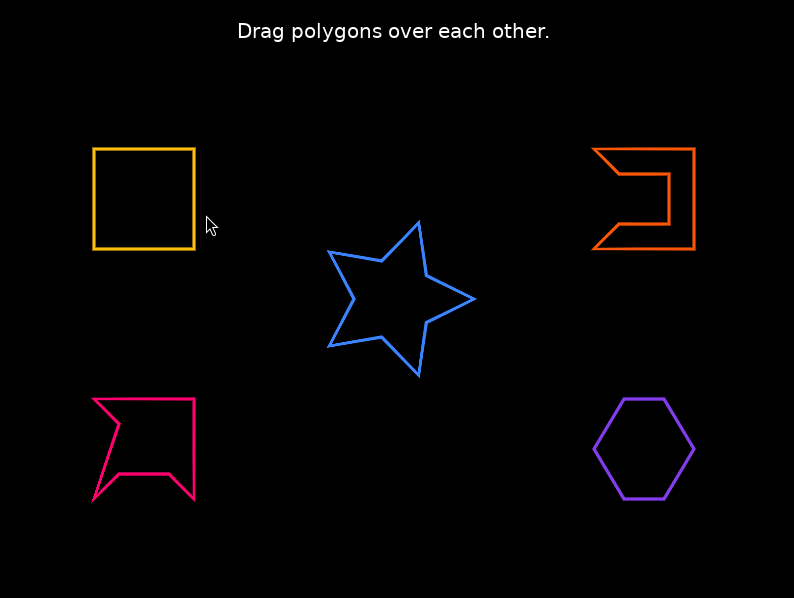Polysec is a framework-agnostic Lua library for detecting intersections and collisions between polygons, circles and rectangles. It provides an efficient algorithm for polygonal intersection detection, making it suitable for the collision handling. While Polysec is independent of any specific framework, it is framework-agnostic.
- Detect point belongs to polygon, circle or rectangle.
- Detect collision of rectangles, circles and polygons.
- Measure distance between two points.
- Checks that two point are equal (have same coordinates).
Under the hood Polysec uses the Weiler-Athethon algorithm to detect polygon intersections.
Before applying the algorithm to a polygon, the following conditions must be met:
- Polygons must be oriented in a clockwise direction.
- Polygons must not be self-intersected (i.e., they should not be re-entrant).
Given polygon A (clipping region) and polygon B (subject region) to be clipped, the algorithm proceeds as follows:
- List the vertices of both polygon A and polygon B.
- Classify each vertex of polygon B as either inside or outside of polygon A.
- Identify all intersection points between the polygons and insert them into both vertex lists, ensuring they are at the intersection points.
- Determine "inbound" intersections, where the vector from an intersection to the next vertex of polygon B originates inside the clipping region A.
- Traverse the lists, following each intersection in a clockwise direction until returning to the starting position.
If no intersections are found, one of the following must be true:
- Polygon A is entirely inside Polygon B.
- Polygon B is entirely inside Polygon A.
- Polygons A and B do not overlap.
local polysec = require("init")
local polygon = polysec.polygon
local point = polysec.point
local square = polygon.new(
point.new(100, 150),
point.new(200, 150),
point.new(200, 250),
point.new(100, 250)
)
local triangle = polygon.new(
point.new(125, 125),
point.new(62.5, 225),
point.new(25, 125)
)
-- If polygons are not overlapping, nil and false are returned. Otherwise
-- returns clipping polygon and true.
local clip, overlaps = polygon.overlaps(square, triangle)
print("Is overlapping: " .. tostring(overlaps))
if clip ~= nil then
for i, p in ipairs(clip) do
print("Point " .. i .. ": {x = " .. p.x .. ", y = " .. p.y .. "}")
end
end
-- Output:
--[[
Is overlapping: true
Point 1: {x = 109.375, y = 150.0}
Point 2: {x = 100.0, y = 165.0}
Point 3: {x = 100, y = 150}
--]]Tip
If you're working exclusively with axis-aligned rectangles, use the orthogonal module for a simpler and more efficient algorithm. For non-rectangular polygons, opt for the polygon module.
local polysec = require("init")
local orthogonal = polysec.orthogonal
local rect = orthogonal.rectangle.new(0, 0, 100, 100)
orthogonal.contain(rect, point.new(50, 50)) --> true
orthogonal.overlap(rect, orthogonal.rectangle.new(50, 50, 75, 75)) --> trueDemos are written in Löve2D Framework. To run demos Löve2D should be installed on your machine.
Use relative paths for demos; this keeps the import path correct.
love ./demos/point-inside
love ./demos/polygon-intersection
love ./demos/rectangle-intersection
love ./demos/circle-intersectionUnit-tests are performed using Laura testing framework. Linting is performed using luacheck.
Unit tests
laura .Lint (code quality)
luacheck src testRun everything with make software
make lint testPoint [number, number]Rectangle number[]Polygon number[]Circle number[]Shape Rectangle | Polygon | Circle | {kind: Kind}
new(x: number, y: number): Point
Creates a new point instance with x and y coordinates.distanceTo(p: Point, q: Point): number
Computes the distance between two points.areEqual(p: Point, q: Point): number
Checks that two points have same coordinates.
new(x1: number, y1: number, x2; number, y2: number): Rectanglenew(p: Point, q: Point): Rectangle
Creates a new rectangle instance.toList(rect: Rectangle): number
Converts the rectangle to the array of numbers.
new(...points: Point[]): Polygon
Creates a new polygon instance.add(...points: Point[]): nil
Adds point(s) to the polygon.toList(): number[]
Converts polygon to the form of array [x1, y1, x2, y2, y3, y3, ..., xN, yN].
new(x: number, y: number, r: number): Circlenew(p: Point, r: number): Circle
Creates a new circle instance.toList(circle: Circle): number
Converts the circle to the array of numbers.
contain(s: Shape, p: Point): boolean
Checks is the point inside a shape. For polygon using the winding number method.
overlap(s: Shape, t: Shape): boolean, Shape?
Checks overlapping of two shapes.
closeTo(a: number, b: number): boolean
Helper function for float equality comparison.isCircle(s: Shape): boolean
Checks that shape is a circle.isPolygon(s: Shape): boolean
Checks that shape is a polygon.isRectangle(s: Shape): boolean
Checks that shape is a rectangle.
rectangle: Rectamgle
Same asrectangleoverlap(s: Rectangle t: Rectangle): boolean
Checks overlapping of two orthogonal rectangles.contain(r: Rectangle, p: Point): boolean
Checks that point is inside orthogonal rectangle.
Epslion: number
A very small number, value is1e-9.
Rectangle = 0Polygon = 1Circle = 2
Any help is appreciated. Found a bug, typo, inaccuracy, etc.? Please do not hesitate to create a pull request or submit an issue.
MIT 2025





